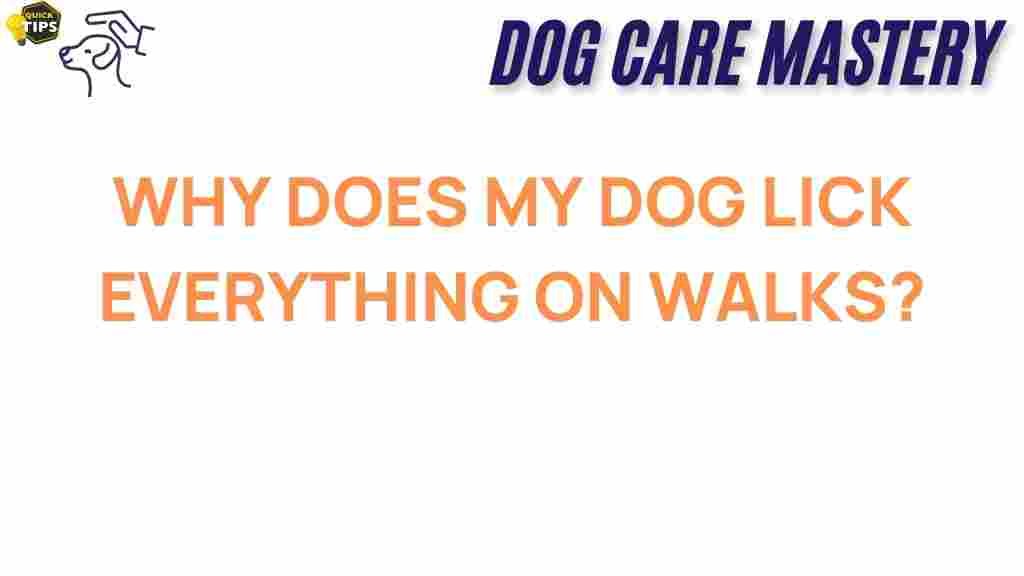Understanding Dog Behavior: Why Does My Dog Lick Everything on Walks?
As a dog owner, you may have noticed your furry friend engaging in some peculiar habits during your daily walks. One of the most common behaviors is licking everything in sight. If you’ve ever wondered, “Why does my dog lick everything on walks?” you’re not alone. This article delves into the intricate world of dog behavior, examining the various reasons behind this licking tendency and offering insights into how you can manage it.
The Basics of Dog Behavior
Before we dive into the reasons for this licking behavior, it’s essential to understand how dogs perceive their environment. Dogs experience the world through smell and taste much more than humans do. Their sense of taste is directly linked to their sense of smell, which means that licking is a natural way for them to explore their surroundings.
Reasons Why Dogs Lick Everything on Walks
There are several reasons why your dog might be licking everything during walks. Here are some of the most common explanations:
- Exploration: Dogs use their tongues to explore new environments. Licking is a way for them to gather information about their surroundings.
- Social Behavior: Licking can also be a social behavior. Dogs often lick each other as a sign of affection or submission.
- Stress or Anxiety: Licking can be a coping mechanism for dogs experiencing stress or anxiety. If your dog is nervous during walks, they might resort to licking as a way to self-soothe.
- Curiosity: Dogs are naturally curious creatures. They may lick objects out of sheer curiosity, especially if they find something interesting.
- Hunger or Thirst: Sometimes, licking can indicate that your dog is hungry or thirsty. If they smell food or water, they may lick as a way to express their desire for it.
- Health Issues: In some cases, excessive licking can be a sign of health problems, such as allergies, skin conditions, or gastrointestinal issues. If you observe this behavior consistently, it’s crucial to consult a veterinarian.
Step-by-Step Guide to Manage Licking Behavior
If your dog’s licking habit is becoming overwhelming, here’s a step-by-step guide to help you manage it:
1. Observe and Identify Triggers
Pay attention to the specific situations or objects that trigger your dog’s licking behavior. Is it certain people, other dogs, or specific areas of your walking route? Keeping a journal can help you track patterns and identify triggers.
2. Redirect the Behavior
When you notice your dog starting to lick, redirect their attention to a toy or treat. This can help break the habit and teach them that there are more appropriate things to focus on during walks.
3. Provide Mental Stimulation
Ensure your dog is mentally stimulated before walks. Engaging them in puzzle toys or teaching them new tricks can help reduce boredom and the urge to lick.
4. Use Positive Reinforcement
Reward your dog when they refrain from licking during walks. Use verbal praise or treats to reinforce good behavior.
5. Maintain a Calm Environment
If your dog is licking due to anxiety, try to create a calm walking environment. Avoid crowded areas and opt for quieter routes where your dog feels more at ease.
6. Consult a Professional
If the licking persists or worsens, consider consulting a professional dog trainer or a veterinarian. They can provide tailored strategies and check for any underlying health issues.
Troubleshooting Common Issues
Here are some common issues related to licking behavior and how to troubleshoot them:
Issue: Licking Other Dogs
If your dog tends to lick other dogs during walks, it could be a sign of social behavior or anxiety. Monitor these interactions and use the redirection technique to guide your dog’s attention elsewhere.
Issue: Licking Random Objects
If your dog is fixated on licking random objects, such as benches, poles, or trash, try to distract them with a toy or treat. Also, be mindful of what they can access on walks.
Issue: Excessive Licking at Home
If you notice your dog licking excessively at home, it may indicate stress or boredom. Ensure they have plenty of opportunities for physical and mental exercise. You might also consider interactive toys to keep them engaged.
The Importance of Regular Vet Check-ups
Regular check-ups with your veterinarian are vital to ensure your dog’s overall health. If licking is accompanied by other symptoms like redness, swelling, or hair loss, it’s crucial to get professional advice. Your vet can help you rule out any health issues that could be contributing to your dog’s licking behavior.
Conclusion
Understanding your dog’s behavior, especially their tendency to lick everything on walks, is crucial for fostering a positive relationship and ensuring their well-being. By observing their behavior, redirecting their attention, and providing mental stimulation, you can help curb excessive licking. Remember, if the behavior persists or if you have concerns about your dog’s health, don’t hesitate to reach out to a veterinarian or professional trainer.
For more information on dog behavior, check out this informative guide that covers various aspects of understanding your dog. Additionally, consider exploring resources from reputable organizations like the American Kennel Club for further insights into canine behavior.
This article is in the category Behavior and created by dogcaremastery Team
